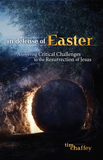
Supernatural or Science: How Do We Explain Miracles?
Christians frequently run into the argument that “The Bible can’t be trusted because it has miracles, and they are clearly not possible because science doesn’t accept the miraculous.” How should believers respond?
The Nature of Miracles
Some events recorded in Scripture seem to be clearly outside of the normal physical processes which govern our world. We do not know all the laws of nature and processes in the world, so it is possible that God worked many miracles within the bounds of the laws of nature that He created and sustained (e.g., miracle of timing, using the creation to do His will). But it is also the case that God works some miracles completely beyond the limitations of the laws of nature that He created (e.g., creation).
Creation ex nihilo (from nothing) was a six-day week of supernatural activity by God beyond what we see today. Unlike most miracles, creation is not bound by being “outside the normal physical processes which govern our world.” There were no processes in place at creation, and since creation is a completely unique event, it is difficult to gauge and classify it other than to say it occurred beyond the laws that were later operating within creation. Since creation, God has imposed natural laws that He established and ordained during Creation Week, and continues to sustain (Genesis 1:14–15, 8:22; Colossians 1:16–17; Hebrews 1:3).
God is not bound by these same laws that He upholds for creation.
However, God is not bound by these same laws that He upholds for creation; He transcends them and gives them their force. And although He usually allows things to occur naturally and can work miracles within that natural law (such as miracles of timing), at times He acts in supernatural ways, which we also call miracles.
For an excellent discussion on what miracles are, see the article “Did Miracles Really Happen?” This article addresses a common scientific objection to miracles. The notion that miracles are impossible because they would (potentially) go beyond the laws of nature is not a rational argument. It merely presupposes the very thing it is supposed to be proving and is thus arbitrary.
When someone says miracles are impossible, they are claiming to have all knowledge and are placing themselves in a position to say miracles are impossible. They claim such things based on limited knowledge and limited experience with comments such as “I’ve never seen one!” When it is pointed out that they have a narrow temporal and historical perspective, they usually reply, “If miracles did occur, then they would be rare occurrences,” to which we would respond, “That’s the point! Miracles are indeed rare events.”
Let’s look at some specific supernatural miracles as recorded in Scripture. Keep in mind that the world is trying to delete any hand of God in miracles and make them naturalistic.
The Resurrection of Christ
The greatest miracle of all time was the Resurrection of Jesus from the grave.
The greatest miracle of all time was the Resurrection of Jesus from the grave. Over the years, skeptics have invented all kinds of naturalistic ways to get around the historical reality of the Resurrection, but each story falls flat.1
One naturalistic explanation that has been offered by skeptics, known as the “swoon theory,” argues that Jesus never died on the Cross. Instead, He simply passed out because of the pain and entered a coma-like state. The soldiers, thinking He was dead, gave His body over to be buried. However, in the natural coolness of the tomb Jesus revived, rolled away the stone, somehow managed to escape the notice of the guards, and appeared to His disciples claiming He had risen from the dead. However, He soon succumbed to His wounds and was buried elsewhere while His disciples began perpetuating the story of a resurrection.
A slight variation on this theory has Jesus purposefully deceiving others by receiving a drink on the Cross that caused Him to lose consciousness. The soldiers again thought He was dead and relinquished the body but only after thrusting a spear through His side to be sure He was dead. This severely wounded Jesus and He died shortly after He was revived.2
Both of these theories fail miserably. Jesus was not “merely” crucified (an excruciating execution method in and of itself), after being up all night, sweating blood, and exhausted by trial after trial, He was also beaten, struck in the face, and scourged. This scourging was not a simple whipping either; it was an intense form of torture that left many dead. After this, a crown of thorns was pushed onto His head and He was beaten with a staff. Then He was crucified.
There is absolutely no possibility that Jesus survived this torture. The Romans who executed Jesus were executioners by trade—they knew what they were doing. They knew whether someone was dead or had merely passed out. In fact, the soldiers were surprised Jesus was already dead and did not break His legs as they often did to speed up death by asphyxiation. Instead, they thrust a spear into His side and blood and water flowed out, showing that Jesus was truly dead.
Furthermore, if by some miracle (and it really would be a miracle!) Jesus survived all this, He would be beaten, bleeding, and barely alive. He certainly would be in no position to escape the tomb and the guards, and He definitely did not look like someone who had just risen triumphantly from the grave, conquering death! Certainly the disciples would never have been willing to endure persecution and martyrdom for a crushed, defeated “Savior.”
Natural explanations for Christ’s resurrection simply do not account for the details surrounding His Crucifixion. Christ’s Resurrection was a miracle that only God could accomplish! It is fascinating that those who argue that Jesus really did not die but survived all this have never been able to produce any historical evidence of anyone who was scourged crucified and stabbed by Roman soldiers and lived.
The Parting of the Red Sea
One of the most celebrated miracles throughout the Old Testament was the miraculous rescue of the Israelites from their Egyptian masters, which climaxed with the parting of the Red Sea. Lately, some scholars have claimed that there is a natural explanation for this historic occasion. This leaves out divine intervention altogether. Do natural explanations hold any water?
The most popular natural explanation for the Red Sea crossing relocates the event from the traditional Red Sea, a large body of water, to the shallow, marshy Sea of Reeds. Proponents of this view claim that a strong wind of around 67–74 miles per hour could have driven back the water and sufficiently dried a reef or mud flat to allow the Israelites a few hours to cross over. The wind then died down and the water rushed back in, thus keeping the Egyptians from pursuing the Israelites.3
This explanation simply does not match the biblical data. Even if the crossing is relocated from the actual Red Sea, Exodus makes it clear that all of Pharaoh’s army drowned. The water could not have been a shallow marsh but must have been deep enough to drown an army complete with chariots and horses (Exodus 14:17, 28).
God’s supernatural usage of a natural phenomenon He created was easily worthy of being called miraculous.
Furthermore, Scripture says that the water was piled up on either side of the fleeing Israelites (Exodus 14:21–22, 15:8; Psalm 78:13). A natural wind will not create two walls of water. Even if it could, a wind powerful enough to blow across a deep body of water and divide it into a wall on either side would certainly prohibit the Israelites from going anywhere!4 Now, we do know that God induced a “strong east wind” to divide the sea in half, but this could not have been an ordinary, natural wind. So God’s supernatural usage of a natural phenomenon He created was easily worthy of being called miraculous.
Jesus Walks on Water
Three of the four Gospels contain the account of Jesus walking toward His disciples on the water (Matthew 14:22–32; Mark 6:45–52; John 6:16–21). Truly this was a miraculous event that showcases Jesus’s power over nature . . . or does it? Skeptics have also offered natural explanations for this miracle. Do these explanations work?
One theory is that Jesus was merely walking along a ledge by the shore and His disciples mistook this as a miraculous walking on the water. All three Gospels, however, record that the boat was far out on the lake—three or four miles, according to John. Jesus would not have been visible along the shoreline, and it is quite absurd to suggest that He found a ledge in the middle of a deep lake. Another explanation is that Jesus was merely riding a low-profile boat that made it appear that He was performing a miracle. However, His boat would have quickly sunk during the storm before He made it close to the disciples.5 Also, neither of these explanations account for how Peter was able to walk toward Jesus across the water before his fear caused him to begin to sink (Matthew 14:28–31). Natural explanations do not account for the details surrounding the event. This was a miracle that demonstrated Christ’s power over nature and its laws.
Conclusion
Since natural explanations fail to account for any of the above miracles, and the events recounted above are all described as works of the Lord or miracles in Scripture (Resurrection of Christ—Romans 6:4–5; Ephesians 1:19–20; Parting of the Red Sea—Exodus 14:13–18, 24–30; Jesus walking on water—Matthew 14:32–33), we have a divine testimony that these events were supernatural. From a scientific standpoint, people today who have been beaten, crucified, and stabbed in the side do not rise from the dead; seas do not part and walls of water do not rise and leave the ground beneath them dry; and barefoot (or sandal-wearing) men cannot walk across the surface of the sea.
Naturalistic scientists presuppose that the universe is structured and follows rational physical laws which can be determined by experimentation and observation. The Bible actually teaches this concept. But why is there constancy in the universe and why does it follow rational laws? Because there is a Creator, because God is logical and has imposed order on the universe. The universe obeys laws because God established them. And God has given us the capability for these laws to be discovered by man; God created our mind—we are made in His image. God also wants us to search out knowledge and understanding (Proverbs 1:5, 4:7, 16:16, 23:23, 25:2).
Does this of necessity mean that science must exclude the miraculous? Since God is capable of creating the universe and establishing the natural laws which govern it, would He not also be able to supersede those laws occasionally when He chooses? It is illogical to think that God could create the universe out of nothing but then would be powerless over it.
There is a Book which tells us when God performed miracles in the course of history.
In fact, if the suspension of natural laws by definition were impossible and “unscientific,” then the supposed big bang is also impossible and unscientific because it presupposes that matter and energy were created by it, which is inconsistent within its own story. In essence, whether an evolutionary scientist wants to admit it or not, they are allowing (and in this case as well as in the case of abiogenesis are actually requiring) miracles within their naturalistic paradigm. Therefore, the claim that science must exclude the supernatural ultimately is unsupportable. Furthermore, there is a Book which tells us when God performed miracles in the course of history.
The Resurrection of Jesus Christ is the most important of these miracles to mankind, as described in 1 Corinthians 15:20–22 and 1 Peter 1:3–5, and is the pivotal point for all of humanity. If you would like to learn more about this miracle and what it means, please read this article about the Good News.
Footnotes
- For more about the Resurrection and secular objections, see Tim Chaffey’s In Defense of Easter: Answering Critical Challenges to the Resurrection of Jesus (Burlington, KY: Midwest Apologetics, 2014).
- Tim Chaffey, “Faking Death,” Answers in Genesis, March 29, 2013, https://answersingenesis.org/jesus-christ/resurrection/faking-death/.
- Amanda Onion, “Scientists Explain Red Sea Parting and Other Miracles,” ABC News, accessed September 29, 2014, http://abcnews.go.com/Technology/story?id=99580.
- Wayne Jackson, “The Parting of the Red Sea: Miracle or Natural Event?” Christian Courier, accessed September 29, 2014, https://www.christiancourier.com/articles/612-the-parting-of-the-red-sea-miracle-or-natural-event.
- “Can’t All Jesus’ Miracles Be Explained Naturally?” Christian Apologetics and Research Ministry, accessed September 29, 2014, http://carm.org/questions/about-jesus/cant-all-jesus-miracles-be-explained-naturally.
Recommended Resources

Answers in Genesis is an apologetics ministry, dedicated to helping Christians defend their faith and proclaim the good news of Jesus Christ.
- Customer Service 800.778.3390
- Available Monday–Friday | 9 AM–5 PM ET
- © 2026 Answers in Genesis




